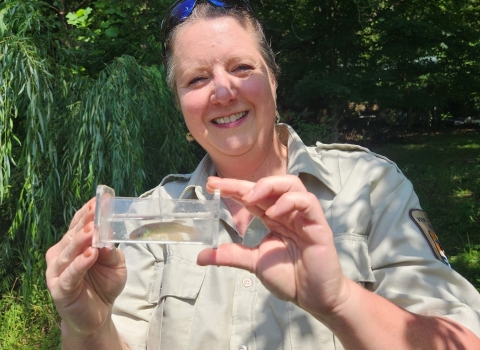This story was written by Science Applications Program Directorate Fellow, Amanda DeVleeschower. Learn more about Science Applications Program here.
Alaska’s name comes from the Indigenous Unangan word Alyeska, which means “great land.” With a vast landscape including mountain peaks, tidal shoreline, volcanoes, millions of lakes, and rivers, it’s easy to understand how Alaska got its name. This great land has a rich diversity of landscapes, with 32 different ecosystems which serve as habitat for a wide variety of wildlife, healthy fish populations and between 7-12 million shorebirds. While the surface of Alaska is awe-inspiring, something just as exciting lies beneath the surface of 85% of Alaska’s land.
Permafrost is ground that has been continually frozen for two or more years. It’s a combination of soil, gravel and sand that is held together by ice. All year round, this permafrost layer is below the surface playing an essential role in the Alaskan ecosystem.
When plants and animals die, the microbes that decompose their bodies release methane, carbon dioxide and other greenhouse gases. However, the deep freeze of the permafrost holds in these organisms and their gases, which means the Alaska permafrost is packed with thousands of years of accumulated plant and animal matter. It’s estimated that there are 1.5 trillion metric tons of carbon encased in the frozen soil.
While Alaska has largely undeveloped landscapes, climate change climate change
Climate change includes both global warming driven by human-induced emissions of greenhouse gases and the resulting large-scale shifts in weather patterns. Though there have been previous periods of climatic change, since the mid-20th century humans have had an unprecedented impact on Earth's climate system and caused change on a global scale.
Learn more about climate change is actively driving change within Alaska’s ecosystems and communities. Alaska is experiencing warming rates twice as fast as the rest of the country and because of this, the frozen permafrost is thawing in many areas. As permafrost thaws, microbes begin the decomposition process and in turn, release carbon dioxide and methane in the atmosphere. With predicted continued temperature increases, the permafrost thawing will release massive amounts of carbon and methane into the air which will warm up the atmosphere even further, creating a feedback loop of continued warming and thawing.
Greenhouse gases aren’t the only thing trapped in the Alaskan permafrost. Microbes including viruses, bacteria, archaea, fungi, and protists are all trapped within the permafrost. These pathogenic microbes may affect human and wildlife health. Some of the microbes, like the 40,000-year-old nematodes (microscopic worms) that researchers have found, haven’t been seen outside of permafrost in thousands of years. Furthermore, radon, mercury, and uranium are also locked in the frozen permafrost and are expected to be released when permafrost thaws, which has the potential to pollute ecosystems including those that native communities rely on for subsistence.
In 2021, Service staff, Tribes, and other partners wanted to better understand Alaska’s permafrost and microbe community, identify high priority needs across Alaska regarding permafrost, and share this information with Alaska’s refuges, Tribes, and local communities.
The Arctic and Yukon Flats Refuges started down the road of understanding the soil in which they were standing on. To provide baseline information on their microbial communities, the Arctic and Yukon Flats Refuges are partnering with the University of Alaska Fairbanks to establish long-term microbe sampling sites. Through this partnership, scientists will be able to determine what microbes are currently in the soil, how they could be changing over time and help inform how ecosystems could be impacted by emerging pathogens.
But scientists aren't the only ones getting involved in this work. With about 230 Federally recognized Tribes in Alaska, Tribal voices and communities are joining in on the conversation. Refuge staff are working with the Council of Athabascan Tribal Governments (CATG) to create a community science project called, “Eyes in the Bush.” Through this project, CATG will hire residents in the communities of Fort Yukon, Venetia, and Circle to document environmental change. Within these communities, observers will monitor snow, thawed permafrost soil and air quality, emerging soil-based pathogens, plant emergence throughout the season, river ice movement, invasive plant growth, and fire patterns.
This information will be input into the Indigenous Sentinels Network (https://www.beringwatch.net/), which is an online system that provides Indigenous communities with tools, training, networking, coordination and capacity for ecological, environmental and climate monitoring.
Jimmy Fox, the Yukon Flats National Wildlife Refuge manager, is incredibly proud of community involvement saying, “People living on the Yukon Flats are our friends and partners. They stepped up to help us and an international group of scientists. Paid with funding from the refuge, employees of the Council of Athabascan Tribal Governments measure the depth of unfrozen soil near their community. This is important because most of the land and water in the basin sits atop thawing permafrost. Monitoring the ’active’ layer above permafrost for change over time is important for communities and scientists.”
Through these partnerships, Service staff, Tribes, and other partners will be able to better understand Alaska’s permafrost and microbe community, identify high-priority needs across Alaska regarding permafrost, and share this information with Alaska’s refuges, Tribes, and local communities. This is the first step in a long road to understand climate change impact on permafrost, and the Service isn’t done yet.
Roger Kaye, the wilderness coordinator for the Arctic National Wildlife Refuge, is focusing on expanding the scientific literature on microbes and their presence in Alaska and creating webinars to address the urgency of this work. Next, Roger wants to extend the microbe soil sampling to all of Alaska’s sixteen wildlife refuges to ensure that more Alaskan landscapes are being monitored effectively. As Alaska enters an unprecedented and unknown future, the collaborations and partnerships being developed now will help Service staff, Tribes, and partners direct Alaska’s future given climate change and better protect the future of Alaskan communities and wildlife.



